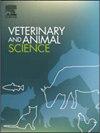Concentrate supplementation during dry season enhance milk yield and quality on dromedary camel in peri urban area of Isiolo, Kenya
IF 1.9
Q2 AGRICULTURE, DAIRY & ANIMAL SCIENCE
引用次数: 0
Abstract
Camel milk contributes 50 % of nutrients among the desert locals in Kenya. However, frequent droughts due to climate change is the major factor affecting milk production in dromedary camels. The objective of this study was to determine the effect of concentrates supplementation on camel milk yield and quality during dry season. A feed supplement containing 17.04 % crude protein and 2864.62 Kcal/kg digestible energy was formulated using wheat bran, sorghum grain, sunflower meal and maize germ. A feeding trial was conducted with four dietary treatments i.e. ad libitum fodder browsing without concentrate supplementation (treatment 1-control) and ad libitum fodder browsing plus 1 kg, 1.5 kg and 2 kg concentrate for treatment 2, 3 and 4 respectively. A 4 × 4 Latin square design was used with eight lactating dromedary camels for 56 days and were supplemented every evening. Milking was done in the morning and milk yield recorded. Body weight and milk samples were taken fortnightly. Milk samples were analyzed for constituents and fatty acid composition. Supplementation slightly increased the protein, fat content and milk yield over the experimental period. Milk protein content for treatment 2 and 4 were similar (2.82 %). Adding 2 kg of concentrate displayed higher milk fat content (3.51 %). Total saturated fatty acids in milk were higher (68.13 %) in treatment 2. Unsaturated fatty acids remained relatively constant under all the treatments (29.9 %). Milk proximate and fatty acid profile indicated stable milk composition and supplementation increased yield. Therefore, supplementing lactating camels during dry season increase milk production.
在肯尼亚Isiolo城郊地区,旱季补充精料可提高单峰骆驼的产奶量和品质
骆驼奶为肯尼亚沙漠居民提供了50%的营养。然而,气候变化导致的频繁干旱是影响单峰骆驼产奶量的主要因素。本研究的目的是确定在旱季补充精料对骆驼奶产量和品质的影响。以麦麸、高粱籽粒、葵花籽粕和玉米胚芽为原料,配制出含17.04%粗蛋白质和2864.62 Kcal/kg消化能的饲料。试验采用不添加精料的自由采食饲料(处理1-对照)和分别添加1 kg、1.5 kg和2 kg精料的自由采食饲料(处理2、3和4)4种饲粮处理。8头哺乳期单峰骆驼采用4 × 4拉丁方设计,连续56 d,每晚补充。在早晨挤奶并记录产奶量。每两周采集一次体重和牛奶样本。分析了牛奶样品的成分和脂肪酸组成。在试验期间,饲粮中添加的蛋白质、脂肪含量和产奶量略有增加。处理2和处理4的乳蛋白含量相近(2.82%)。添加2 kg精料,乳脂含量较高(3.51%)。处理2乳中总饱和脂肪酸含量较高(68.13%)。不饱和脂肪酸在所有处理下保持相对稳定(29.9%)。牛奶近似值和脂肪酸谱表明牛奶成分稳定,添加牛奶可提高产量。因此,在旱季补充哺乳期骆驼可以增加产奶量。
本文章由计算机程序翻译,如有差异,请以英文原文为准。
求助全文
约1分钟内获得全文
求助全文
来源期刊

Veterinary and Animal Science
Veterinary-Veterinary (all)
CiteScore
3.50
自引率
0.00%
发文量
43
审稿时长
47 days
 求助内容:
求助内容: 应助结果提醒方式:
应助结果提醒方式:


